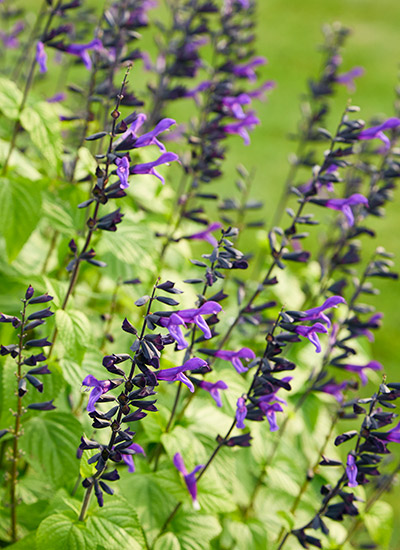
When long-blooming tender salvias are packaged in 4-in. pots and lined up along the greenhouse benches at the nursery in spring, it’s difficult to believe that their handful of compact bloom spikes daintily dancing above tidy foliage could make an impact on the garden. But these plants get better all season and are problem-solvers for tricky situations: They tolerate clay soils and periods of drought, handle high heat, don’t mind humidity, and deer don’t eat them. If you’re looking for low maintenance and long blooming, these plants fit the bill.
Even better, pollinators love them — especially hummingbirds. Salvia's tubular flowers are built to fit a hummingbird’s beak, dusting their foreheads with pollen as they drink. In return, hummingbirds get a taste of the sucrose-rich nectar, which not all plants supply. So let’s explore the salvias that rule late-season gardens, whether they bloom from summer to frost, or, like the red pineapple salvia pictured above, wait until shorter daytime hours to reveal their irresistible flowers.
You Might Also Like:
11 Deer- and Rabbit-Resistant Plants
8 Late-Season Flowers
Colorful Fall Garden Bed Plan
10 Plants to Attract Hummingbirds to Your Garden
Growing long blooming salvia
Good news: Salvias are not very finicky about their growing conditions and can grow in dense clay, hot and humid weather and even handle drought conditions. Many — but not all — types of sages are native to the Southwestern United States and Central America, a region characterized by tough growing conditions.
Sun is best when you want maximum blooms from your salvia. Though some can tolerate a little shade, too much shade along with soil that’s too rich might make their stems flop. And, even though salvias tolerate clay soil just fine, soil that holds too much moisture makes it harder for marginally hardy salvias to survive the winter. Instead, plant them in well-drained, lean soil and mulch the plant in fall for extra protection. Even though salvias tolerate some drought, they flower best with even moisture and need a little watering to get through long dry spells.
Deadheading salvia
It’s not necessary to deadhead salvias but doing so will encourage additional blooms to take off more quickly. You can pinch or snip stems back to the leaf nodes for most species, or cut stems back to the base of the plant for Mexican bush sage (Salvia leucantha), to keep a tidier look.
Take cuttings in fall
If they’re hardy for you, divide salvias every 3 to 5 years to keep plants vigorous. For salvias that aren’t hardy in your area, take cuttings in fall with these simple steps:
- Snip off a non-flowering stem just below a leaf node so that the cutting is about 3 in. long.
- Trim off the bottom set of leaves, dip the stem in rooting hormone and plant it in moist potting mix.
- Keep the cuttings moist and in indirect light until they root in about two weeks.
- Then keep the young plants in a cool spot indoors in bright, south-facing window or under grow lights until spring. Soon you’ll have more salvias for next year or for sharing with others.






















